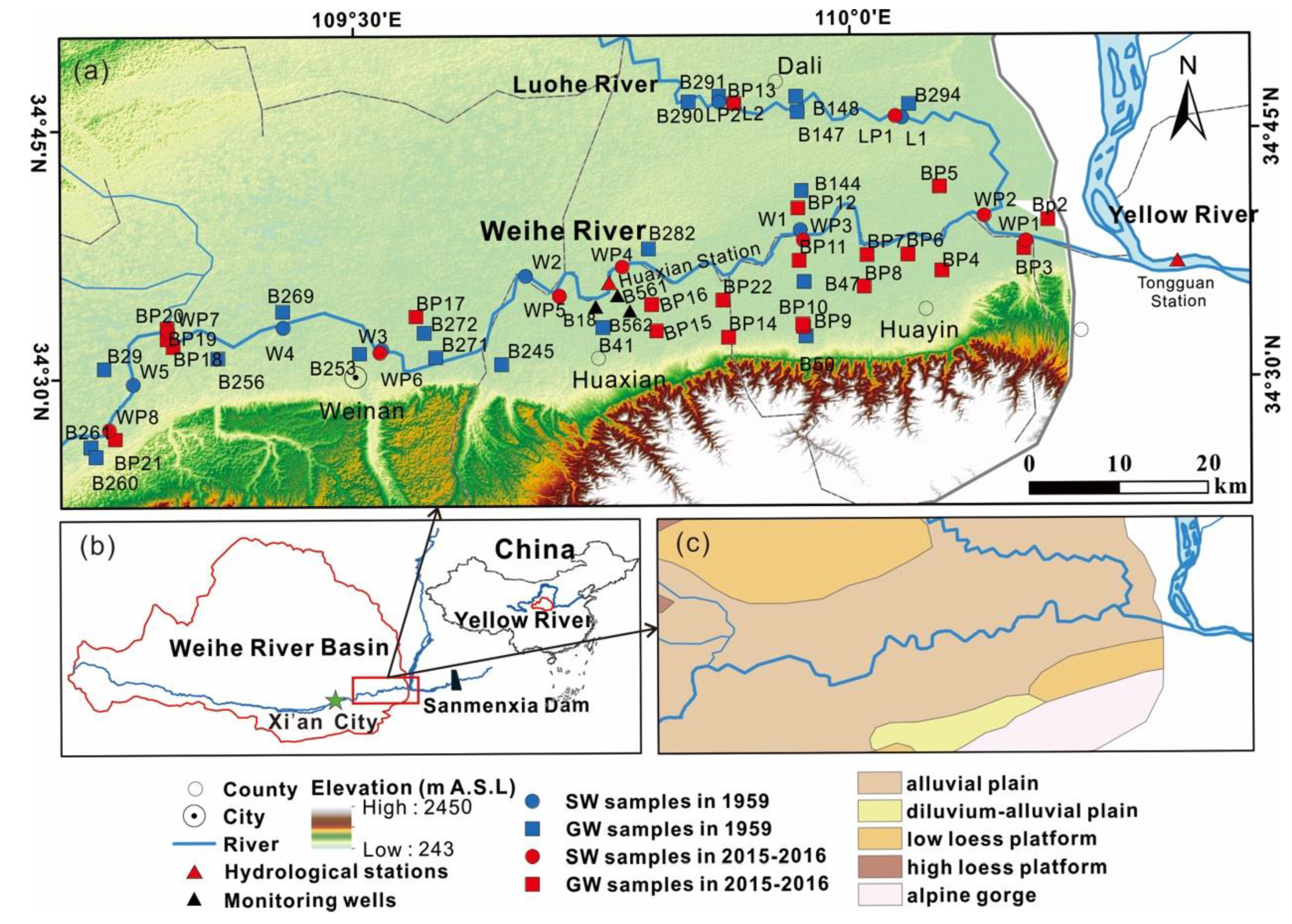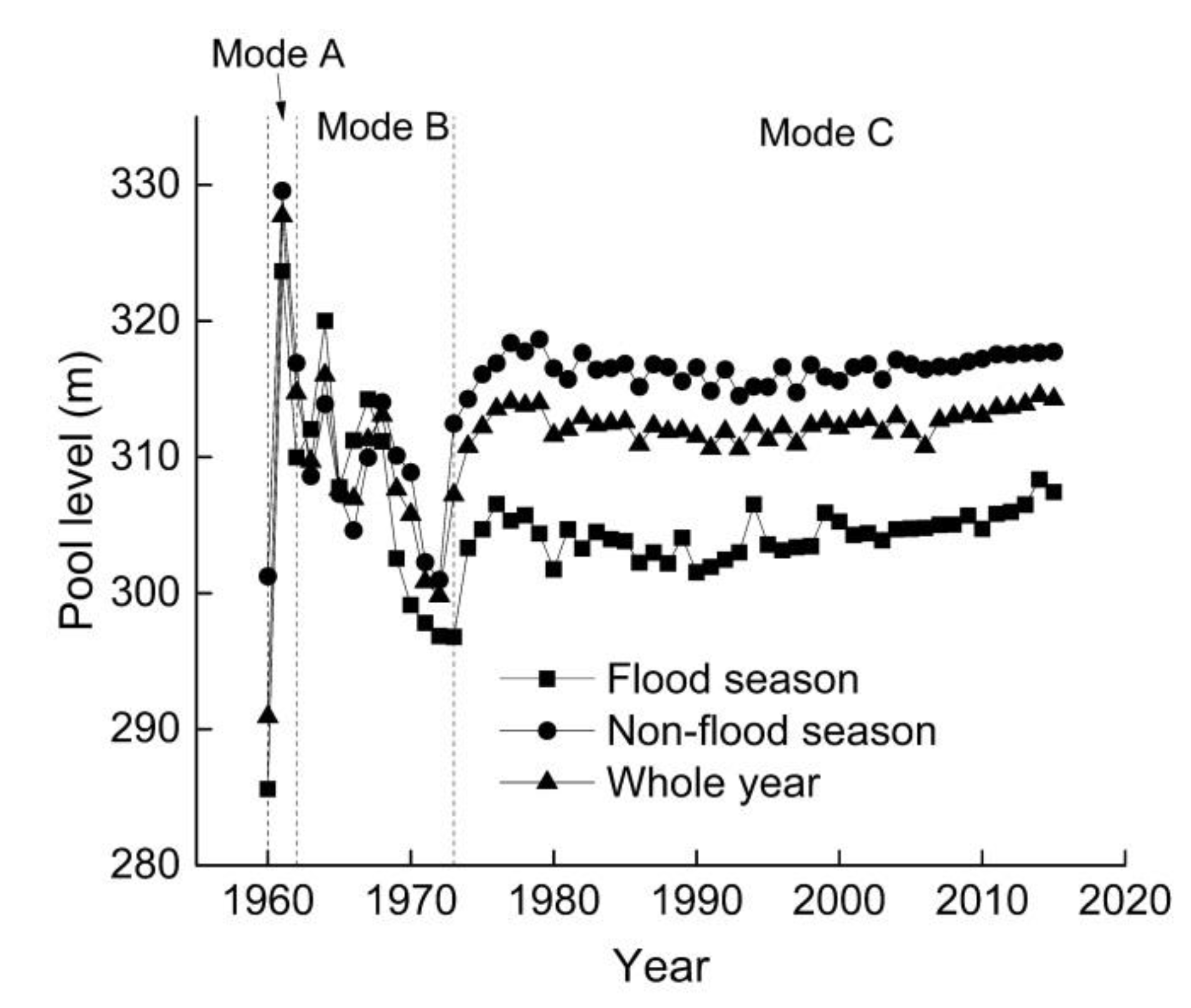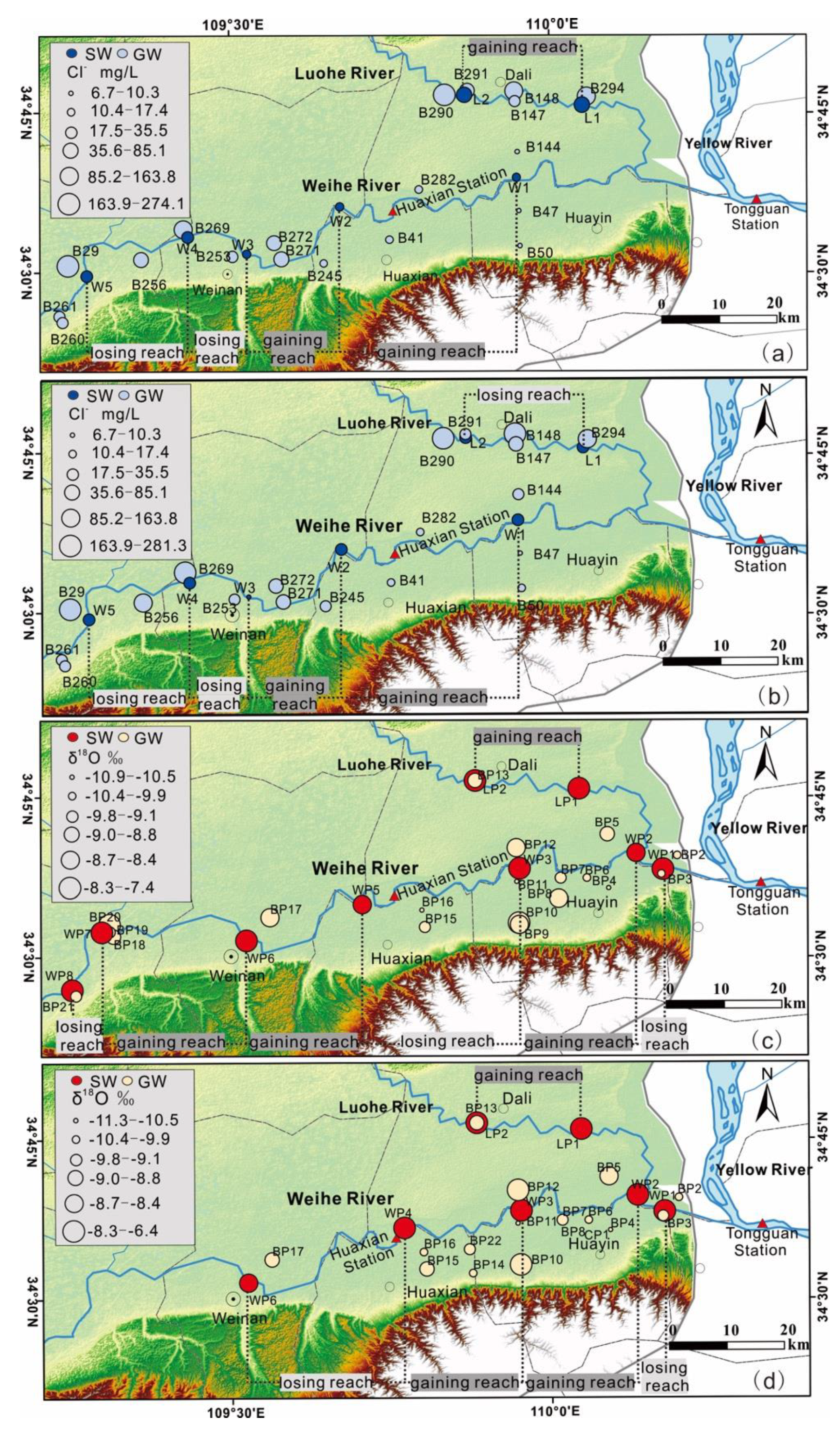Impacts of the Sanmenxia Dam on the Interaction between Surface Water and Groundwater in the Lower Weihe River of Yellow River Watershed
Abstract
1. Introduction
2. Study Area
2.1. The Lower Weihe River
2.2. Sanmenxia Dam
3. Materials and Methods
3.1. Data Collection
3.2. Water Sampling
3.3. Analytical Techniques
3.4. Statistical Method
4. Results
4.1. Water Level Variations
4.2. Hydrochemical Characteristic in Waters
4.2.1. Hydrochemical Characteristics before the Dam Operation
4.2.2. Current Hydrochemical Characteristics
4.3. Stable Isotope Characteristic in Water
5. Discussion
5.1. Surface Water and Groundwater Interaction Variations
5.2. Anthropogenic Sources and Impacts on Surface Water and Groundwater
5.3. Conceptual Model and Environmental Implications
6. Conclusions
- (1)
- At the Huaxian Station, the dam operation plays a key role in raising the SW level. After the 1980s, the GW level decreased because of the increased groundwater exploitation. The variations of SW and GW levels induced the shift of SW–GW interaction. Three different patterns of the SW–GW interaction can be identified in the past 60 years including (i) gaining reach during the early stage (i.e., in 1959), (ii) gaining reach in non-flood season and losing reach in flood season (i.e., in 1981), and (iii) losing reach in 2002 and 2010.
- (2)
- Detailed SW–GW interaction patterns along the lower Weihe River are first examined from the multi-environmental tracers (Cl−, δ18O, and δ2H) of the water samples. Before the dam operation, the channels upstream W3 are losing reaches, while downstream W3 are gaining reaches. In the current status, the distribution of SW–GW interaction along the Weihe River is more complex. Some channels downstream W3 are losing reaches, which may result from the rising SW level induced by the dam operation. Gaining reaches also appeared upstream W3, indicating the impact of the dam lessens as the distance increase. The impact of the dam on the SW–GW interaction can reach to W3 (65 km from the estuary of the Weihe River).
- (3)
- In general, the hydro-environment deteriorates in 2015–2016 especially for the NO3− and Cl− concentrations as the population and fertilizer consumption escalated during the last 60 years. Four water types can be distinguished in the lower Weihe River Basin. No SW samples showed obvious anthropogenic input in 1959, but, in 2015–2016, 72.7% of SW samples (mean nitrate concentration of 34.7 mg/L) were affected by agricultural input. A total of 78.2% of the GW samples in 1959 show no obvious anthropogenic input, while 34.1% of GW samples (mean nitrate concentration of 124.7 mg/L) in 2015–2016 are affected by agricultural or domestic inputs. GW sampling sites of BP2, BP11, and BP17 (mean Cl− concentration of 372.2 mg/L) might be affected by industrial input in the rural area.
- (4)
- Evidence has also shown that different SW–GW interaction patterns may produce different influences on the water system. The impacts of the dam which change the SW–GW interaction patterns and make the water system more variable present a challenge to water resource management in this area. Further research may focus on how the different SW–GW interaction patterns affect the pollutant migration and make a suitable operation mode of the dam to improve the local water resources management.
Supplementary Materials
Author Contributions
Funding
Conflicts of Interest
References
- Sophocleous, M. Interactions between groundwater and surface water: The state of the science. Hydrogeol. J. 2002, 10, 52–67. [Google Scholar] [CrossRef]
- Winter, T.C. Ground Water and Surface Water: A Single Resource; DIANE Publishing Inc.: Darby, PA, USA, 1998; Volume 1139. [Google Scholar]
- Essaid, H.I.; Caldwell, R.R. Evaluating the impact of irrigation on surface water—Groundwater interaction and stream temperature in an agricultural watershed. Sci. Total Environ. 2017, 599–600, 581–596. [Google Scholar] [CrossRef]
- Fernald, A.G.; Guldan, S.J. Surface Water–Groundwater Interactions Between Irrigation Ditches, Alluvial Aquifers, and Streams. Rev. Fish. Sci. 2007, 14, 79–89. [Google Scholar] [CrossRef]
- Dun, Y.; Tang, C.; Shen, Y. Identifying interactions between river water and groundwater in the North China Plain using multiple tracers. Environ. Earth Sci. 2013, 72, 99–110. [Google Scholar] [CrossRef]
- Jolly, I.D.; McEwan, K.L.; Holland, K.L. A review of groundwater-surface water interactions in arid/semi-arid wetlands and the consequences of salinity for wetland ecology. Ecohydrology 2008, 1, 43–58. [Google Scholar] [CrossRef]
- Woessner, W.W. Stream and fluvial plain ground water interactions: Rescaling hydrogeologic thought. Groundwater 2000, 38, 423–429. [Google Scholar] [CrossRef]
- Epting, J.; Huggenberger, P.; Radny, D.; Hammes, F.; Hollender, J.; Page, R.M.; Weber, S.; Banninger, D.; Auckenthaler, A. Spatiotemporal scales of river-groundwater interaction—The role of local interaction processes and regional groundwater regimes. Sci. Total Environ. 2018, 618, 1224–1243. [Google Scholar] [CrossRef]
- Graf, W.L. Dam nation: A geographic census of American dams and their large-scale hydrologic impacts. Water Resour. Res. 1999, 35, 1305–1311. [Google Scholar] [CrossRef]
- Lu, X.X.; Siew, R.Y. Water discharge and sediment flux changes over the past decades in the Lower Mekong River: Possible impacts of the Chinese dams. Hydrol. Earth Syst. Sci. 2006, 10, 181–195. [Google Scholar] [CrossRef]
- Kondolf, G.M.; Rubin, Z.K.; Minear, J.T. Dams on the Mekong: Cumulative sediment starvation. Water Resour. Res. 2014, 50, 5158–5169. [Google Scholar] [CrossRef]
- New, T.; Xie, Z.J.B. Impacts of large dams on riparian vegetation: Applying global experience to the case of China’s Three Gorges Dam. Biodivers Conserv 2008, 17, 3149–3163. [Google Scholar] [CrossRef]
- Francis, B.A.; Francis, L.K.; Cardenas, M.B. Water table dynamics and groundwater-surface water interaction during filling and draining of a large fluvial island due to dam-induced river stage fluctuations. Water Resour. Res. 2010, 46. [Google Scholar] [CrossRef]
- Arntzen, E.V.; Geist, D.R.; Dresel, P.E. Effects of fluctuating river flow on groundwater/surface water mixing in the hyporheic zone of a regulated, large cobble bed river. River Rese. Appl. 2006, 22, 937–946. [Google Scholar] [CrossRef]
- Gu, B.; Ge, Y.; Chang, S.X.; Luo, W.; Chang, J. Nitrate in groundwater of China: Sources and driving forces. Glob. Environ. Chang. 2013, 23, 1112–1121. [Google Scholar] [CrossRef]
- Yadav, R.K.; Goyal, B.; Sharma, R.K.; Dubey, S.K.; Minhas, P.S. Post-irrigation impact of domestic sewage effluent on composition of soils, crops and ground water—A case study. Environ. Int. 2002, 28, 481–486. [Google Scholar] [CrossRef]
- Sun, B.; Zhang, L.; Yang, L.; Zhang, F.; Norse, D.; Zhu, Z. Agricultural Non-Point Source Pollution in China: Causes and Mitigation Measures. AMBIO 2012, 41, 370–379. [Google Scholar] [CrossRef] [PubMed]
- Leschik, S.; Musolff, A.; Krieg, R.; Martienssen, M.; Bayer-Raich, M.; Reinstorf, F.; Strauch, G.; Schirmer, M. Application of integral pumping tests to investigate the influence of a losing stream on groundwater quality. Hydrol. Earth Syst. Sci. 2009, 13, 1765–1774. [Google Scholar] [CrossRef]
- Teng, Y.; Hu, B.; Zheng, J.; Wang, J.; Zhai, Y.; Zhu, C. Water quality responses to the interaction between surface water and groundwater along the Songhua River, NE China. Hydrogeol. J. 2018, 26, 1591–1607. [Google Scholar] [CrossRef]
- Weng, H.; Chen, X. Impact of polluted canal water on adjacent soil and groundwater systems. Environ. Geol. 2000, 39, 945–950. [Google Scholar] [CrossRef]
- Squillace, P.J.; Thurman, E.M.; Furlong, E.T. Groundwater as a nonpoint source of atrazine and deethylatrazine in a river during base flow conditions. Water Resour. Res. 1993, 29, 1719–1729. [Google Scholar] [CrossRef]
- Wang, G.; Wu, B.; Wang, Z.-Y. Sedimentation problems and management strategies of Sanmenxia Reservoir, Yellow River, China. Water Resour. Res. 2005, 41. [Google Scholar] [CrossRef]
- Wang, Z.Y.; Wu, B.; Wang, G. Fluvial processes and morphological response in the Yellow and Weihe Rivers to closure and operation of Sanmenxia Dam. Geomorphology 2007, 91, 65–79. [Google Scholar] [CrossRef]
- Li, J.; Li, H.; Shen, B.; Li, Y. Effect of non-point source pollution on water quality of the Weihe River. Int. J. Sediment Res. 2011, 26, 50–61. [Google Scholar] [CrossRef]
- Zhang, Z.M.; Wang, X.Y.; Zhang, Y.; Nan, Z.; Shen, B.G. The Over Polluted Water Quality Assessment of Weihe River Based on Kernel Density Estimation. Proced. Environ. Sci. 2012, 13, 1271–1282. [Google Scholar] [CrossRef]
- Oh, Y.-Y.; Hamm, S.-Y.; Yoon, H.; Kim, G.-B. Analytical and statistical approach for evaluating the effects of a river barrage on river-aquifer interactions. Hydrol. Process. 2016, 30, 3932–3948. [Google Scholar] [CrossRef]
- Kalbus, E.; Reinstorf, F.; Schirmer, M. Measuring methods for groundwater? surface water interactions: A review. Hydrol. Earth Syst. Sci. Discuss. 2006, 10, 873–887. [Google Scholar] [CrossRef]
- Lewandowski, J.; Lischeid, G.; Nützmann, G. Drivers of water level fluctuations and hydrological exchange between groundwater and surface water at the lowland River Spree (Germany): Field study and statistical analyses. Hydrol. Process. 2009, 23, 2117–2128. [Google Scholar] [CrossRef]
- de Brito Neto, R.T.; Santos, C.A.G.; Mulligan, K.; Barbato, L. Spatial and temporal water-level variations in the Texas portion of the Ogallala Aquifer. Nat. Hazards 2016, 80, 351–365. [Google Scholar] [CrossRef]
- Han, Q.; Zhang, S.; Huang, G.; Zhang, R. Analysis of Long-Term Water Level Variation in Dongting Lake, China. Water 2016, 8, 306. [Google Scholar] [CrossRef]
- Oyarzún, R.; Jofré, E.; Morales, P.; Maturana, H.; Oyarzún, J.; Kretschmer, N.; Aguirre, E.; Gallardo, P.; Toro, L.E.; Muñoz, J.F.; et al. A hydrogeochemistry and isotopic approach for the assessment of surface water–groundwater dynamics in an arid basin: The Limarí watershed, North-Central Chile. Environ. Earth Sci. 2014, 73, 39–55. [Google Scholar] [CrossRef]
- Yang, L.; Song, X.; Zhang, Y.; Han, D.; Zhang, B.; Long, D. Characterizing interactions between surface water and groundwater in the Jialu River basin using major ion chemistry and stable isotopes. Hydrol. Earth Syst. Sci. 2012, 16, 4265–4277. [Google Scholar] [CrossRef]
- Menció, A.; Mas-Pla, J. Assessment by multivariate analysis of groundwater–surface water interactions in urbanized Mediterranean streams. J. Hydrol. 2008, 352, 355–366. [Google Scholar] [CrossRef]
- Négrel, P.; Petelet-Giraud, E.; Barbier, J.; Gautier, E. Surface water–groundwater interactions in an alluvial plain: Chemical and isotopic systematics. J. Hydrol. 2003, 277, 248–267. [Google Scholar] [CrossRef]
- Zhu, M.; Wang, S.; Kong, X.; Zheng, W.; Feng, W.; Zhang, X.; Yuan, R.; Song, X.; Sprenger, M. Interaction of Surface Water and Groundwater Influenced by Groundwater Over-Extraction, Waste Water Discharge and Water Transfer in Xiong’an New Area, China. Water 2019, 11, 539. [Google Scholar] [CrossRef]
- National Earth System Science Data Center, National Science & Technology Infrastructure of China. Available online: http://www.geodata.cn (accessed on 8 February 2020).
- Huh, Y.; Tsoi, M.-Y.; Zaitsev, A.; Edmond, J.M. The fluvial geochemistry of the rivers of Eastern Siberia: I. tributaries of the Lena River draining the sedimentary platform of the Siberian Craton. Geochim. Cosmochim. Acta 1998, 62, 1657–1676. [Google Scholar] [CrossRef]
- Edmond, J.M.; Palmer, M.R.; Measures, C.I.; Grant, B.; Stallard, R.F. The fluvial geochemistry and denudation rate of the Guayana Shield in Venezuela, Colombia, and Brazil. Geochim. Cosmochim. Acta 1995, 59, 3301–3325. [Google Scholar] [CrossRef]
- Mann, H.B. Nonparametric test against trend. Econometrica 1945, 13, 245–259. [Google Scholar] [CrossRef]
- Zhang, Q.; Li, J.; David Chen, Y.; Chen, X. Observed changes of temperature extremes during 1960–2005 in China: Natural or human-induced variations? Theor. Appl. Climatol. 2011, 106, 417–431. [Google Scholar] [CrossRef]
- Zhang, G. Mechanism of Riverbed Aggradation at Tongguan Reach and Channel Shrinkage at Lower Weihe River. Master’s Dissertation, Xi’an University of Technology, Xi’an, China, 2002. [Google Scholar]
- Han, D.; Song, X.; Currell, M.J.; Cao, G.; Zhang, Y.; Kang, Y. A survey of groundwater levels and hydrogeochemistry in irrigated fields in the Karamay Agricultural Development Area, northwest China: Implications for soil and groundwater salinity resulting from surface water transfer for irrigation. J. Hydrol. 2011, 405, 217–234. [Google Scholar] [CrossRef]
- Solomon, D.K.; Cook, P.G. Environmental Tracers in Subsurface Hydrology; Springer: New York, NY, USA, 2000. [Google Scholar]
- Scanlon, B.R.; Jolly, I.; Sophocleous, M.; Zhang, L. Global impacts of conversions from natural to agricultural ecosystems on water resources: Quantity versus quality. Water Resour. Res. 2007, 43. [Google Scholar] [CrossRef]
- Ramakrishnaiah, C.R.; Sadashivaiah, C.; Ranganna, G. Assessment of Water Quality Index for the Groundwater in Tumkur Taluk, Karnataka State, India. E-J. Chem. 2009, 6, 757424. [Google Scholar] [CrossRef]
- Kumar, P.S. Evolution of groundwater chemistry in and around Vaniyambadi industrial area: Differentiating the natural and anthropogenic sources of contamination. Chem. Erde-Geochem. 2014, 74, 641–651. [Google Scholar] [CrossRef]
- Park, S.-C.; Yun, S.-T.; Chae, G.-T.; Yoo, I.-S.; Shin, K.-S.; Heo, C.-H.; Lee, S.-K.J.J.O.H. Regional hydrochemical study on salinization of coastal aquifers, western coastal area of South Korea. J. Hydrol. 2005, 313, 182–194. [Google Scholar] [CrossRef]
- Wang, M.; Webber, M.; Finlayson, B.; Barnett, J. Rural industries and water pollution in China. J. Environ. Manag. 2008, 86, 648–659. [Google Scholar] [CrossRef] [PubMed]











| B18 | B561 | B562 | SW | Precipitation | |
|---|---|---|---|---|---|
| B18 | 1 | ||||
| B561 | 0.99 ** | 1 | |||
| B562 | 0.97 ** | 0.98 ** | 1 | ||
| SW | 0.85 ** | −0.32 | −0.35 | 1 | |
| Precipitation | 0.29 * | 0.20 | 0.21 | 0.29 | 1 |
| Year | Huaxian Station (m) | B18 (m) | B561 (m) | B562 (m) |
|---|---|---|---|---|
| 1959 | 333.36 | 335.60 | - | - |
| 1981 | 335.21 | 335.34 | 335.15 | 335.01 |
| 2002 | 336.61 | - | 332.35 | 331.10 |
| 2010 | 336.44 | - | 334.29 | 333.88 |
| Type | Relative Abundance | Period | Percentage of Different Water Types | |
|---|---|---|---|---|
| SW | GW | |||
| A | Low Cl−–low NO3− | Pre 1 | 100.0% | 78.2% |
| B | Low Cl−–High NO3− | Pre | 0.0% | 12.7% |
| C | High Cl−–low NO3− | Pre | 0.0% | 7.3% |
| D | High Cl−–High NO3− | Pre | 0.0% | 1.8% |
| A | Low Cl−–low NO3− | Post 2 | 13.6% | 43.9% |
| B | Low Cl−–high NO3− | Post | 72.7% | 34.1% |
| C | High Cl−–low NO3− | Post | 0.0% | 19.5% |
| D | High Cl−–high NO3− | Post | 13.6% | 2.4% |
© 2020 by the authors. Licensee MDPI, Basel, Switzerland. This article is an open access article distributed under the terms and conditions of the Creative Commons Attribution (CC BY) license (http://creativecommons.org/licenses/by/4.0/).
Share and Cite
Zhang, D.; Han, D.; Song, X. Impacts of the Sanmenxia Dam on the Interaction between Surface Water and Groundwater in the Lower Weihe River of Yellow River Watershed. Water 2020, 12, 1671. https://doi.org/10.3390/w12061671
Zhang D, Han D, Song X. Impacts of the Sanmenxia Dam on the Interaction between Surface Water and Groundwater in the Lower Weihe River of Yellow River Watershed. Water. 2020; 12(6):1671. https://doi.org/10.3390/w12061671
Chicago/Turabian StyleZhang, Dong, Dongmei Han, and Xianfang Song. 2020. "Impacts of the Sanmenxia Dam on the Interaction between Surface Water and Groundwater in the Lower Weihe River of Yellow River Watershed" Water 12, no. 6: 1671. https://doi.org/10.3390/w12061671
APA StyleZhang, D., Han, D., & Song, X. (2020). Impacts of the Sanmenxia Dam on the Interaction between Surface Water and Groundwater in the Lower Weihe River of Yellow River Watershed. Water, 12(6), 1671. https://doi.org/10.3390/w12061671






